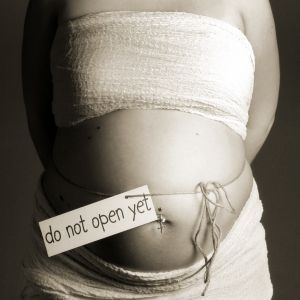Many infants suffer from eye problems. It is quite common. Here is a guide to six eye problems that new parents might face with their babies.
1) Clogged Tear Duct
My daughter was born with a clogged tear duct. From the first day she had matted tears in her eye lashes and in the corner of her eye. I massaged her eye with a warm wash cloth and by the time she was a year old the blockage was gone.
Your tear ducts lead from the inside corner of the eye and into the nose. Some babies are born with a blockage in this area which causes the tears to build up in the corner of the eye instead of draining. Normally you will simply massage the eye with a warm washcloth a couple of times a day. By age one the tear duct normally opens up and the baby is just fine. On rare occasions a doctor will need to perform a minor surgery to unblock the duct.
2) Amblyopia
Many people call this a ‘lazy eye’. Many babies suffer from an imbalance between their two eyes. This imbalance causes the baby to use one eye more then the other. This will cause the unused eye to loose vision and become ‘lazy’. This situation needs to be treated before the child reaches the age of ten or the loss of vision will be permanent. Many times the problem can be rectified by eye glasses or having the child wear an eye patch to build up strength in the eye over time.
3) Ptosis
Many infants are born with a droopy eyelid. This is often not discovered until the child is a few months old and the mother notices that one eye appears smaller then the other. This condition can be fixed with a minor surgery.
4) Retinopathy of Prematurity
Many babies who are born early do not have enough time to develop blood vessels correctly in one or both eyes. This condition causes damage to the eye or eyes. All premature babies should have a ophthalmic exam done within the first two weeks of life to catch this condition before too much damage is done. They eye or eyes can be treated to prevent damage that is irreversible if left to advance.
5) Visual inattention
When a baby reaches the age of six to eight weeks they should pay close attention to any visual stimuli. They will like lights, toys waved in front of them, and they will adore their mothers face above all else. Babies love it when you smile and talk animated to them as they stare at your face. If your child does not enjoy all of this at by the age of eight weeks then you need to see your pediatrician.
Many babies will suffer a delay in their visual ability. This is common in premature infants but also seen often in full term babies. Some babies just require more time for their eyes to develop but other babies might be suffering from a serious disease that will require treatment before vision loss happens or becomes permanent. If a baby is not responding to visual stimuli by three months of age then a professional eye exam will be required.
6) Cataracts
Some babies are born with cataracts. Many parents find this startling. It is often discovered at a well baby exam by your pediatrician when they detect a white cloudiness in the infants eye. Parents also sometimes see this when gazing into their babies eyes. Surgery is required to fix infants with cataracts.
Sources:
http://www.uic.edu/com/eye/LearningAboutVision/EyeFacts/BabyEyes.shtml
http://eyedoctor.homestead.com/BabyEyes.html




